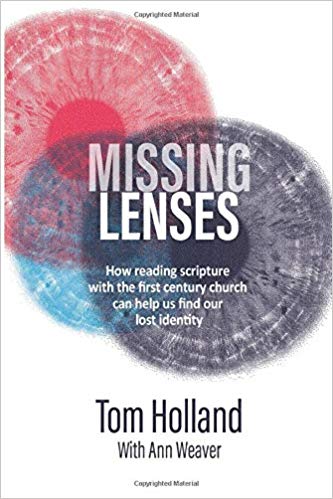A Book Review from Books at a Glance
By Mark Baker
Editor’s Note: We have arranged for a 50% discount on the Kindle version of this book for our readers – this week only!
Whenever someone asks me what I think of N. T. Wright, it’s going to be more than a one sentence answer. I’m going to speak about how I appreciate his scholarship, mention his superb writing skills, and finish with some specific cautions about how I don’t follow many of his conclusions, specifically when it comes to Paul’s theology. I have often wished for someone who could present the storyline of the Bible in the same compelling manner but without the need for so many caveats.
Then I encountered Tom Holland’s work. He might be hard to find because he shares a name with Marvel’s latest rendition of Spiderman and with an ancient historian, but Holland is one of England’s best kept secrets. Holland’s latest book, Missing Lenses, is a lay-level treatment of his more academic work, Contours of Pauline Theology (Mentor: 2010). Missing Lenses is divided into three parts; part 1 covers the Hebrew background of the New Testament, part 2 focuses on the corporate lens in which the Bible is read, and part 3 addresses what Holland calls the “Passover lens.”
Using the familiar metaphor of “lenses” through which one interprets the biblical storyline, Holland suggests that Western biblical interpreters have primarily been reading the Bible through the wrong lenses (3). Lamentably, the New Testament letters are read “as describing individual experience and personal morality” (6). It’s like “looking through the wrong end of a telescope” (6). Furthermore, these Western lenses have been shaped by Greek thought, particularly dualism, and this focus has obscured clear references to the Old Testament (7).
To put it positively, throughout the book, Holland develops twin pillars of proper interpretation: corporate, not individual; Hebrew, not Greek. Though Holland’s claims are broad-sweeping, he is careful to provide caveats at just the right moment. Though the New Testament (NT) should be read through a corporate lens, this interpretation in no way downplays the need for individual salvation (90). Though Paul’s Hebraic worldview should dominate the way the NT is interpreted, there is a place for interacting with Greek thought; it should simply not dominate the conversation (44).
Holland provides a compelling case study about the translation of the Greek word doulos. Those who lean more towards a Greco-Roman influence might translate the word “slave,” whereas those who focus on the Hebrew background would translate it “servant.” Holland demonstrates that this decision has great theological implications, because the Hebrew concept of “servant” is a theologically rich concept that ultimately points to Christ. We might miss these linguistic nuances if we lean too heavily toward a Greco-Roman influence.
On the other end of the spectrum, those who do interpret the NT through more of a Jewish lens are often overly occupied with Second Temple Jewish documents. Holland laments the fact that a cross reference to the Dead Sea Scrolls is often seen as more significant than a cross reference to the Old Testament. Yet again, Holland does not dismiss the usefulness of such Jewish literature, but rather he states that “the extent of its relevance for interpreting the New Testament message must be questioned” (27).
Furthermore, Holland makes a strong point about the corporate nature of Paul’s letters. He states that “the letters are not about what God has done or is doing for the individual Christian. They are about what God has done or is doing for his new covenant people, the church” (83). He sees a strong Exodus motif as the backdrop of Romans (114), and the “I” of Romans 7, Holland interprets as a subset of redeemed humanity—both Jews and Gentiles—who looked to God in faith (139–141). Throughout all of part 3, Holland demonstrates how the “Paschal Exodus imagery” is thoroughly embedded in the story of the NT (282).
Certainly, with all of Holland’s bold claims, readers will not follow him in every jot and tittle of his interpretation. For example, some of Holland’s linguistic comments could be aided by recent scholarship on linguistics. The claim that the Septuagint created a “unique semantic range” for Greek words used in the NT (42) might need to be chastened by the careful linguistic comments of Charles Lee Irons in The Righteousness of God (WUNT: 2015) or even the cautions a generation ago from James Barr in The Semantics of Biblical Language (Oxford: 1961). Some readers may not find every NT echo to the Paschal Exodus compelling. Nevertheless, I want to stand up and cheer when I see an argument for interpreting the Bible not with Western eyes but with eyes firmly fixed on the story of the Bible itself. Furthermore, Holland is clear without being dry, and strongly opinionated while providing necessary caveats. Perhaps next time someone asks me what I think of N. T. Wright, I will first introduce that person to the work of Tom Holland.
Mark Baker is a PhD candidate at Southeastern Baptist Theological Seminary. He is also an elder at Christ Church and Dean of Faculty at Paideia Academy, both in Knoxville, TN.
Copyright 2019, Books at a Glance
Books At a Glance book summaries are available by subscription only and except for brief quotes may not be reproduced, in whole or in part, without express, written permission.
